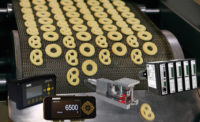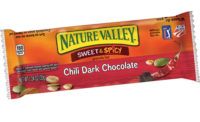Today’s bakers and snack producers say customers want mass customization, smaller case counts and more product varieties. To address these issues, equipment manufacturers have developed flexible automatic systems with smart technology that can handle more product and package formats, sizes and counts than ever, allowing customers to compete in global and local food markets.
Snack manufacturers and bakers are developing a wide range of new products, prompting many a plant manager to automate food packaging and palletizing operations to curb manual labor costs. In turn, equipment manufacturers have responded to their needs by developing flexible equipment that can handle a variety of product and package formats, sizes and counts.
Bakers and snack manufacturers can no longer produce a small number of products on long-sustained production runs. Consumers now demand more products in more varieties, in a greater range of delivery and packaging options to accommodate their changing health, taste, image and cost preferences.
“There’s a continued push to provide solutions that can handle a wide number of stock-keeping units (SKUs),” says Rick Hoskins, director of sales and marketing, at Colborne Foodbotics, Lake Forest, IL. “As the emphasis on product innovation in the snack food and bakery industries continues, it means our customers are introducing more products, thus driving up the number of different products our packaging systems must handle.”
“Because smaller snack food and bakery producers are automating to save money, packaging systems have to be very flexible and forgiving,” says Rocco Fucetola, northeast regional sales manager for BluePrint Automation, South Chesterfield, VA. “These smaller companies still rely on either copacking operations or smaller order sizes, which normally require frequent line changeovers.”
Increased mass customization
Growing market segmentation plays a major role in the need for a variety of product/packaging configurations, which in turn, increases downstream production requirements. In addition, bakers and snack food producers need to balance the demands associated with branded products versus private-label to maintain a foothold in existing markets, which are becoming increasingly segmented, according to Mike Wagner, global OEM business manager for packaging, Rockwell Automation, Milwaukee. “They simultaneously need to compete against [both] global and local food manufacturers in emerging markets, such as China, India and Latin America,” he explains. “These trends directly impact the need for smart, flexible machines that can handle a wider variety of package sizes, shapes and materials.”
Snack manufacturers and bakers are also trying to create unique value for their products, which requires changing product formats and packaging to suit different types of retailers and a wider variety of consumers, adds Shishir Rege, product marketing manager, Yaskawa Motoman, Miamisburg, OH. “We are moving from an era of a mass production to mass customization,” he says. “This requires constant changeovers and the ability handle multiple sizes and shapes of products. Robotic systems add tremendous value in making packaging lines more changeover-friendly.”
Equipment design factors
Designing automated packaging equipment for bakers and snack producers presents challenges to equipment manufacturers. “Automation takes up a large amount of square footage,” says Michael G. Smith, director of project development, Stellar, Jacksonville, FL. “This makes it difficult to integrate automation into an existing facility. New facilities need to be adequately designed to include the square footage requirements that will meet automation needs.”
In addition, large retailers are putting increased pressure on suppliers to minimize the cost of handling product in the store. “The latest initiative is called ‘case-and-a-half,’ which means that large retailers such as Walmart and Target don’t want their shelf stockers to have to rework product and cases,” says Fucetola. “Their goal is that once a case comes out of storage or a warehouse, no partial case goes back in. To do this, case counts have been reduced, so that when a full case is brought out, its entire contents must fit onto the space left on the shelf.” He adds that smaller case counts force machinery to run faster at food-processing plants, which sometimes need to use more corrugated cases.
The fact that baked goods are living, breathing products must be also taken into account, points out Hoskins. “Snack food and bakery products have significant tolerance and behavioral issues that can affect automation,” he says. “Designing these variables into an automated system is important.”
Fully functional robotics, devices
Blueprint Automation recently added an automated changeover features on its core case-packing machines. “Our Delta VPP robotic vertical case packer is a good example of this,” says Fucetola. “We’ve taken our standard offering for the bakery and snack food market and created a new platform that allows the end user to have full functionality in automated changeovers and new product recipe creation, while giving the system a smaller footprint at less cost.”
As an add-on to its robotic basket-loading systems, Colborne Foodbotics has launched a new basket-stacking device that includes an integrated hand cart destacking and loading system. This system automatically stacks baskets and positions them onto hand carts used throughout the snack food and baking industries.
As the secondary contract packaging market is booming, contract manufacturers also need adaptability to allow their lines to accommodate a multitude of products from various manufacturers, says Rege. To meet that need, Yaskawa Motoman recently introduced a Delta-style 3-kg.-payload-capacity robot that features +/- 0.1-mm repeatability, while maintaining a 150+ cycles/minute speed with a full payload.
“Flexibility offered by robotics in case-packing and palletizing, as well as upstream in high-speed picking, makes contract packaging lines more adaptable, creating cost-effective solutions,” Rege says. “Also, as green or eco-friendly initiatives are taking off, packaging is getting thinner and more fragile. The thinner packages require soft handling, which is a challenge for hard-automation machines. Robots are suitable for this type of package handling.”
Rockwell Automation’s RAPID Line Integration technology has become popular with food-packaging machine builders and end users, according to Wagner. “The technology uses PackML to enable an easier linkage between machines and across an entire packaging operation,” he says. “This allows plant managers to monitor machines in a connected, standardized format, giving them visibility into the throughput of each machine and a centralized view of overall line performance.
“The technology also helps lower the total cost of deploying and operating equipment because it uses a platform that easily interfaces with performance-management systems. It can be implemented on new or existing lines that use varying control platforms, allowing plant managers to standardize the integration process.”
What’s new in vision and inspection?
Machine vision and inspection are key parts of the automation process as well. To that end, Cognex Corp., Natick, MA, recently introduced OCRMax, an optical recognition tool for reading and verifying text. “We want to be able to verify the print quality of production or lot codes for traceability and expiration dates,” says John Stamos, a Cognex product marketing manager. “Legible character printing on a high-speed packaging line has always been a challenge. Reliably reading these characters at high speeds has traditionally been even harder to do.
“With OCRMax, we’ve built dozens of parameters to account for all of the typical variations one might experience through the life of the print—things like skew and width variation from a variable-speed line. Being able to account for this variability leads to higher read rates and greater throughput.”
And this is only a handful of the new systems available. The passage of the Food Safety Modernization Act (FSMA) allows the Food and Drug Administration (FDA) to be more proactive in managing food safety. Among many requirements, FSMA calls for food producers to have a plan in place to take corrective action in the event of a food hazard, which will create even more demand for automated processes.
“Traceability has always been asked for, to a certain extent,” Stamos adds. “Today, there’s a different level of scrutiny. Many food recalls involve unspecified or unlabeled allergens. Companies need to use vision and auto-ID technology to validate packaging and, in many cases, track the product.”











